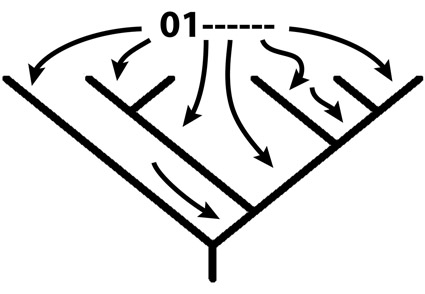Abstract
A method is presented for correlating phylogenetic characters through cladistic analysis. It extends the use of phylogenetic datasets for diagnostic purposes. It improves matrix-based identification tools by predicting novel character-state combinations that were not observed when the key was constructed. By interpreting homoplasy as analytical error, hypothetical character-state combinations are tested for the homoplasy that they would add to the shortest tree(s). The correlation is equal to the homoplasy summed across all state combinations, divided by a maximum possible value. The results depend on uncertainty about the sequence of state transitions and their overlap among characters. A correlation index r is proposed for sets of non-additive characters; it is a kind of multiple-regression value, and its ensemble value R is a statistic of a whole matrix. This approach can be used to select sets of the best "proxy" characters to substitute for unobservable characters of interest. The concept can be extended to continuous characters. Worked examples are given with datasets of various insect orders.
References
Adamski, D. & Brown, J.W. (2002 [2001]) Systematic revision of the Ecdytolopha group of genera (Lepidoptera: Tortricidae: Grapholitini) in the New World. Entomologica Scandinavica, Supplement 58, 1–86.
Carpenter, J.M. (1988) Choosing among multiple equally parsimonious cladograms. Cladistics, 4, 291–296. https://doi.org/10.1111/j.1096-0031.1988.tb00476.x
Dallwitz, M.J. (1974) A flexible computer program for generating identification keys. Systematic Zoology, 23, 50–57. https://doi.org/10.1093/sysbio/23.1.50
Farris, J.S. (1969) A successive approximations approach to character weighting. Systematic Zoology, 18 (4), 374–385. https://doi.org/10.2307/2412182
Farris, J.S. (1979) The information content of the phylogenetic system. Systematic Zoology, 28 (4), 483–519. https://doi.org/10.2307/sysbio/28.4.483
Felsenstein, J. (1985) Phylogenies and the comparative method. American Naturalist, 125 (1), 1–15. https://doi.org/10.1086/284325
Fitch, W.M. (1971) Toward defining the course of evolution: minimum change for a specific tree topology. Systematic Zoology, 20 (4), 406–416. https://doi.org/10.1093/sysbio/20.4.406
Goloboff, P. & Catalano, S. (2016) TNT, version 1.5, with a full implementation of phylogenetic morphometrics. Cladistics, 32 (3), 221–238. https://doi.org/10.1111/cla.12160
Hall, A.V. (1970) A computer-based system for forming identification keys. Taxon, 19 (1), 12–18. https://doi.org/10.2307/1217908
Hennig, W. (1965) Phylogenetic systematics. Annual Review of Entomology, 10, 97–116. https://doi.org/10.1146/annurev.en.10.010165.000525
Lafontaine, J.D. & Schmidt, B.C. (2010) Annotated check list of the Noctuoidea (Insecta, Lepidoptera) of North America north of Mexico. ZooKeys, 40, 1–239. https://doi.org/10.3897/zookeys.40.414
Lees, D.C. & Smith, N.G. (1991) Foodplant associations of the Uraniinae (Uraniidae) and their systematic, evolutionary, and ecological significance. Journal of the Lepidopterists' Society, 45 (4), 296–347.
Lucidcentral (2021) Lucid Player. Version 4. Available from: https://www.lucidcentral.org/index.php/lucid-player/ (accessed 4 April 2021).
Mikkola, K. (1998) Revision of the genus Xylomoia Staudinger (Lepidoptera: Noctuidae), with descriptions of two new species. Systematic Entomology, 23, 173–186. https://doi.org/10.1046/j.1365-3113.1998.00055.x
Nasserzadeh, H., Alipanah, H. & Gilasian, E. (2017) Phylogenetic study of the genus Sternolophus Solier (Coleoptera, Hydrophilidae) based on adult morphology. ZooKeys, 712, 69–85. https://doi.org/10.3897/zookeys.712.14085
Nixon, K.C. & Carpenter, J.M. (2012) On homology. Cladistics, 28, 160–169. https://doi.org/10.1111/j.1096-0031.2011.00371.x
Nixon, K.C. & Davis, J.I. (1991) Polymorphic taxa, missing values and cladistic analysis. Cladistics, 7, 233–241. https://doi.org/10.1111/j.1096-0031.1991.tb00036.x


